

There’s a Badge For That. 2/26/2014 By: Richard Ferdig and Kristine Pytash Digital badges have captured the imagination of many educators, including those frustrated with current assessment techniques and practices.
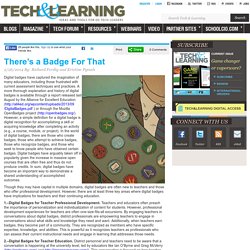
A more thorough explanation and history of digital badges is available through a report released last August by the Alliance for Excellent Education ( ) or through the Mozilla OpenBadges project ( However, a simple definition for a digital badge is digital recognition for accomplishing a skill or acquiring knowledge after completing an activity (e.g., a course, module, or project).
In the world of digital badges, there are those who create badges, those who attempt to achieve badges, those who recognize badges, and those who seek to know people who have obtained certain badges. Digital badges have arguably taken off in popularity given the increase in massive open courses that are often free and thus do not produce credits. 1. 2. 3. 1. 2. 3.
Open Badges Research & Badge System Design Call, Feb. 5, 2014. Using Badges to Quantify Learning Outcomes at UC Davis. Questions of legitimacy are currently keeping badges from being more widely adopted in higher education. The word “badge” itself calls to mind images of summer camps and knot-tying, not academic achievement. But badges have the ability to communicate much more than a letter grade in an abbreviated course title. Badges could be the answer to unclear transcripts, and even be the solution to credit transfer problems between schools. Logically, the objective for those wishing to further the badge concept is pursuing some sort of accreditation for a badge system, right? For answers, I sought out the badge expert at one of the only schools that is attempting to incorporate badges into their curriculum: UC Davis ’ Joanna Normoyle. Joanna is the Experiential and Digital Media Learning Coordinator for the Agricultural Sustainability Institute at UC Davis .
How to use digital badges to help your classroom teaching (essay) The open badge movement has stemmed from the independent learning and massive open online course (MOOC) frameworks of empowering and motivating learners to complete noncredit academic work, either from a distance or at a self designated pace.
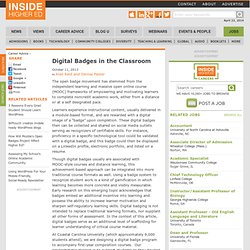
Report: Digital Badges Help Learners Demonstrate Accomplishments, Need Documentation for Credibility. Badging | News.

Learning - Leading. Www.macul.org/downloads/journals/macul_journal_fall_2013_20130730_122011_1.pdf. Digital Badges for Professional Development. Higher education institutions and other organizations interested in supporting learning are experimenting with digital badges to guide, motivate, document, and validate formal and informal learning.
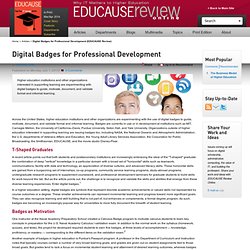
Across the United States, higher education institutions and other organizations are experimenting with the use of digital badges to guide, motivate, document, and validate formal and informal learning. Badges are currently in use or in development at institutions such as MIT, Carnegie Mellon, the University of California–Davis, Purdue University, Seton Hall, and Yale University. Organizations outside of higher education interested in supporting learning are issuing badges too, including NASA, the National Oceanic and Atmospheric Administration, the U.S. departments of Veterans Affairs and Education, the Young Adult Library Services Association, the Corporation for Public Broadcasting, the Smithsonian, EDUCAUSE, and the movie studio Disney-Pixar.
T-Shaped Graduates. Www.2mbetterfutures.org/wp-content/uploads/2013/11/Expanding-Workforce-and-Education-Opportunities-through-digital-badges.pdf. UC Davis's groundbreaking digital badge system for new sustainable agriculture program. The University of California at Davis is creating what may be higher education’s most promising digital badge system.

But the badges are no threat to the university’s degrees. They’re add-ons – perhaps valuable ones for students. “Badges can tell a different story,” says Joanna Normoyle, the experiential and digital media learning coordinator at the university’s Agricultural Sustainability Institute. She says they allow students to “differentiate themselves and tell a narrative.” Normoyle has helped lead the effort by faculty and staff members at UC-Davis to create a badging system for a new undergraduate major in sustainable agriculture and food systems. The idea was hatched as the university worked toward the 2011 launch of the sustainable ag major. The new curriculum is particularly hands-on, with lots of experiential learning that occurs outside the classroom, such as through internships and fieldwork.
There are seven core competencies in the program. Model Could Spread. The Teacher's Guide To Badges In Education. What encourages students to do well in school?
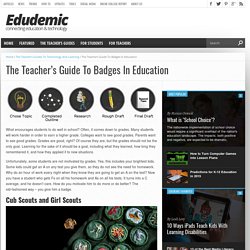
Often, it comes down to grades. Many students will work harder in order to earn a higher grade. Colleges want to see good grades. Parents want to see good grades. Grades are good, right? Unfortunately, some students are not motivated by grades. Cub Scouts and Girl Scouts Boys and girls in the scouting program earn patches for three things: progressing through the scouting program, attending a special event, or accomplishing a specific goal. The patches are a source of pride to the scout who earned them, and they are a way to show off what they have accomplished to others. Www.macul.org/downloads/journals/macul_journal_fall_2013_20130730_122011_1.pdf. Badging the Library, Part 1: What and Why. Digital badges. Digital badges are a validated indicator of accomplishment, skill, quality or interest that can be earned in various learning environments.[1] Origin and Development[edit] Showing a user's group of badges from Mozilla's Badge Backpack.
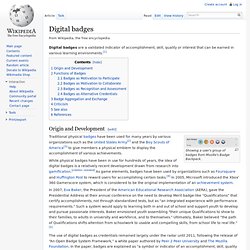
Traditional physical badges have been used for many years by various organizations such as the United States Army[2] and the Boy Scouts of America[3] to give members a physical emblem to display the accomplishment of various achievements. While physical badges have been in use for hundreds of years, the idea of digital badges is a relatively recent development drawn from research into gamification. [citation needed] As game elements, badges have been used by organizations such as Foursquare and Huffington Post to reward users for accomplishing certain tasks.[4] In 2005, Microsoft introduced the Xbox’ 360 Gamerscore system, which is considered to be the original implementation of an achievement system. Functions of Badges[edit] Criticism[edit] See also[edit]
How Badges Really Work in Higher Education. IT Trends | Feature Page 5 of 5 How Badges Really Work in Higher Education Grant estimates that it may be five years before university presidents and provosts start feeling real pressure to have badge programs.
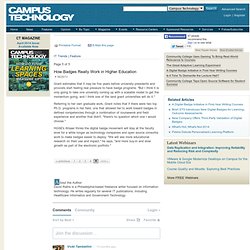
"But I think it is only going to take one university coming up with a scalable model to get the momentum going, and I think one of the land grant universities will do it. " Secure Social Learning Platform. Rethinking Digital Badges. Over the past couple of years, digital badges have become a hot topic in higher education.

In his poem “Thirteen Ways of Looking at a Blackbird,” Wallace Stevens writes that he was “of three minds / Like a tree / In which there are three blackbirds.”